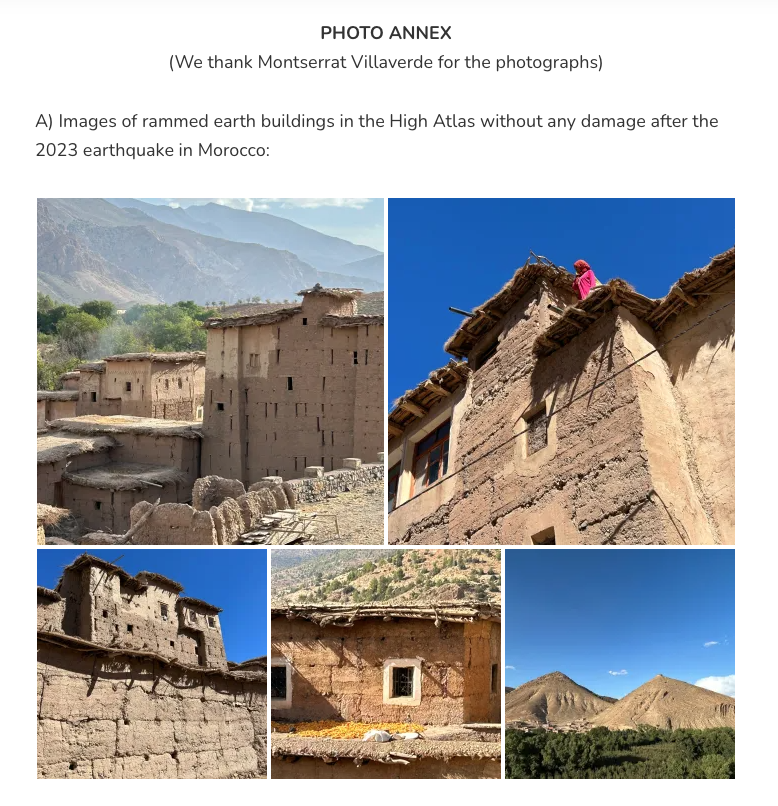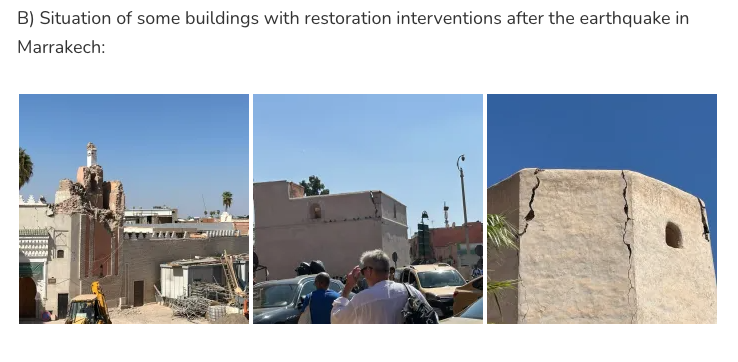ICOMOS-USA and World Heritage USA share the sentiments expressed in this statement produced by the ICOMOS National Committee of Spain and the International Scientific Committee on Earthen Architectural Heritage (ISCEAH) and reproduced below:
Madrid, 14 September 2023
We are deeply saddened by the recent earthquake in Morocco and subsequent loss of human life. No consolation can be offered for this human tragedy. From ICOMOS-Spain and ISCEAH we would like to transmit our deepest heartfelt condolences to the loved ones of those who have lost their lives or been wounded as a result of this earthquake.
Moreover, the damage caused to vernacular and monumental architectural heritage has been extensive. It has been disheartening to see how in some cases the media have reported that the collapse of buildings is due to them being “old houses, built of clay and adobe.” In relation to this, ICOMOS-Spain and ISCEAH would like to state the following:
- These types of traditional construction are part of the culture of Maghreb, which is thousands of years old. The best technical and material solutions, extracted from natural surroundings, have provided a sustainable response to their needs, including seismic needs, following a lengthy empirical process of trial and error.
- The architecture of the past does not collapse simply because it is old or built using traditional materials. Equally, modern architecture does not remain standing during an earthquake simply because it is new or built using more modern materials.
- In the event of an earthquake, any structure or building, whether old or new, can collapse due to lack of maintenance, pre-existing pathologies, incorrect design or deteriorated anti-seismic mechanisms. Although regulations on earthquake resistance in new construction in Morocco have been in place since 2001, housing which is deficient in structural terms continues to be built, mostly due to the lack of resources.
- Irrespective of the materials, height and age of the buildings affected by the earthquake, collapses occur when these construction are built either on the fault or very close to it.
- Another possible cause for the collapse of historic structures could be consolidation or reinforcement interventions, carried out with rigid and incompatible materials, which have proved to be counterproductive despite the implementation of the Seismic Regulations for Earthen Architecture in Morocco in 2013.
-
Many of the images and accounts of buildings in ruins shown in the media have blamed these collapses of construction on materials such as clay, rammed earth and adobe. These images make no distinction between contemporary and older construction (generally stone masonry construction and not adobe or rammed earth). Moreover, there is visual evidence of consolidation and restoration interventions using construction materials or systems that are unsuitable or incompatible with each other.
It is not possible to judge the current ongoing situation without a precise assessment of the buildings including – among other parameters – their current condition and previous situation. Vernacular architecture can collapse, in the same way that modern architecture can. Hasty, arbitrary and inaccurate conclusions which blame the damage or collapse of construction on their age or traditional materials do not positively contribute to protecting and preserving our common heritage. In contrast, it is essential to raise awareness among the population that this type of architecture is not only a sustainable medium to produce wealth, but also valuable cultural heritage which needs care and maintenance. Therefore, guaranteeing its survival to be remembered and appreciated by future generations is a collective responsibility, one in which heritage education and the correct dissemination of architectural knowledge play a basic role.
Images below shared from ISCEAH website: https://isceah.icomos.org/?p=534


